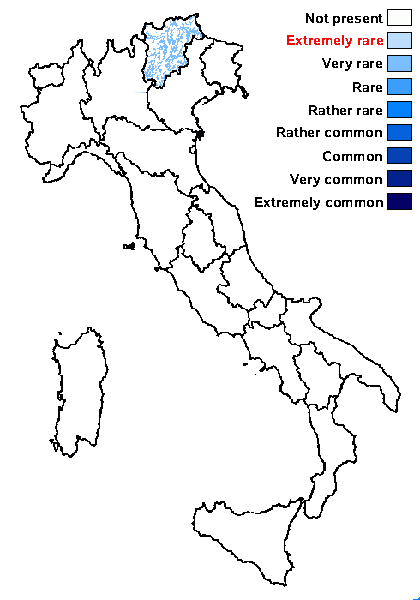Mycobilimbia olivacea Aragón, Sarrión & Hafellner
in Sarrión & al., Lichenologist, 35: 3, 2003.
Synonyms:
Distribution: N - TAA (Thor & Nascimbene 2007, Nascimbene & al. 2022).
Description: Thallus crustose to subsquamulose, episubstratic, continuous, dark green to dark olive-brown, of more or less imbricate, 0.2-0.7(-l) mm wide, flat to convex, thinly corticate areoles with sinuate to lobulate margins. Apothecia lecideine to biatorine, 0.2-0.8(-l) mm across, sessile and more or less constricted at base, with a flat to convex, dark reddish brown disc, and a thin, finally excluded proper margin. Proper exciple 48-55 µm wide laterally, the outer part prosoplectenchymatous, reddish brown, of 6-8 µm wide cells, the inner part paler, with up to 13 µm wide cells; epithecium ochraceous brown, 5-12 µm high; hymenium colourless, 45-80 µm high; paraphyses sparingly branched and anastomosing, 1.5-2.5 µm thick at mid-level, the apical cells 3-4(-5) µm wide, with an orange-brown apical cap; hypothecium colourless, 50-70(-75) µm high, with photobiont cells in inner part. Asci 8-spored, clavate, with a thick, K/I + dark blue apical apparatus containing a K/I+ darker blue tubular pore. Ascospores 1-celled, hyaline, elongate to subcylindrical or ovoid, (9-)11-15(-17) x 5-6.5(-7.5) µm, with a smooth epispore. Photobiont chlorococcoid, the cells 5-9 µm in diam. Spot tests: thallus K-, C-, KC-, P-, UV-. Chemistry: without lichen substances.Note: on bark, mainly of conifers, at the base of trunks. The Italian material differs from the description in the paler thallus and in not having biseriately arranged spores. According to Printzen (in litt.) the species is likely to be related to Lecidea berengeriana. It is included in the Italian red list of epiphytic lichens as “Data Deficient” (Nascimbene & al. 2013c).
Growth form: Crustose
Substrata: bark and lignum
Photobiont: green algae other than Trentepohlia
Reproductive strategy: mainly sexual
Commonnes-rarity: (info)
Alpine belt: absent
Subalpine belt: absent
Oromediterranean belt: absent
Montane belt: very rare
Submediterranean belt: absent
Padanian area: absent
Humid submediterranean belt: absent
Humid mediterranean belt: absent
Dry mediterranean belt: absent

Predictive model
Growth form: Crustose
Substrata: bark and lignum
Photobiont: green algae other than Trentepohlia
Reproductive strategy: mainly sexual
Commonnes-rarity: (info)
Alpine belt: absent
Subalpine belt: absent
Oromediterranean belt: absent
Montane belt: very rare
Submediterranean belt: absent
Padanian area: absent
Humid submediterranean belt: absent
Humid mediterranean belt: absent
Dry mediterranean belt: absent

Predictive model
 Index Fungorum
Index Fungorum
 GBIF
GBIF


